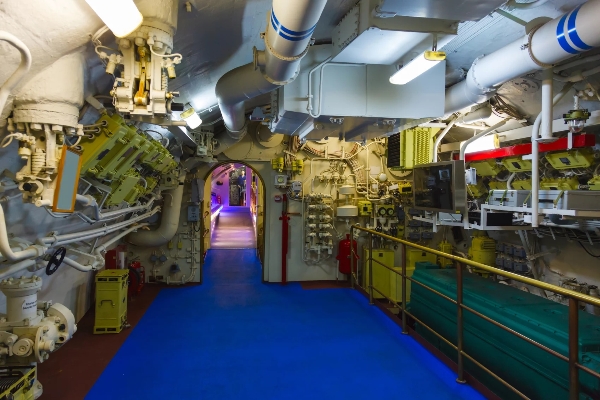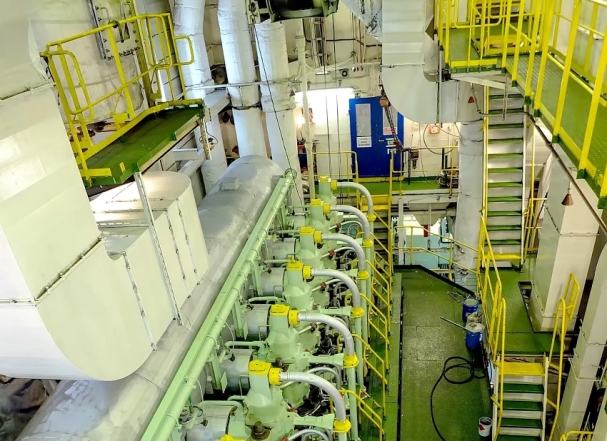The proper functioning of lubrication systems is of crucial importance to commercial and military vessels, since these systems help ensure the reliable operation of dozens of other vital ship mechanisms. Propeller shafts and thrusters, steering gears, deck cranes, winches, and turrets—virtually any gear that is supported by bearing components such as rollers, spines, gears, ball bearings, or other moving parts—need lubrication to fend off corrosion.
Unfortunately, many automated lubrication systems—the preferred solution to regulating and dispensing the necessary lubrication to bearing points—are also subject to caustic corrosion.
Corrosion presents one of the greatest challenges to marine vessels, particularly corrosion by seawater and salt air, which is exacerbated by warm air and high humidity. Each year, the cost of corrosion for the global marine industry ranges between $50 and $80 billion, including the costs of maintenance, repairs, and downtime, according to NACE International.1
For example, in July 2016, the USS Freedom—one of the newest littoral combat ships from the U.S. Navy (Washington, DC)—experienced a casualty to one of the ship's main propulsion diesel engines, caused by significant damage to the engine from rust and seawater.2 The attached seawater pump mechanical seal had experienced a leak, which resulted in seawater entering into the lube oil system and corroding the engine.
Encapsulating lubrication system metering valves in epoxy has long been considered as one solution, but that route can result in long-term equipment servicing problems, according to Lubrication Scientifics (Irvine, California), a manufacturer of automatic lubrication systems and system components.
Instead, they say a better solution could be to use costly—yet more economical—stainless steel (SS).
Because aqueous corrosion is an electrochemical process, most metals and alloys are subject to various degrees of corrosion, pitting, erosion, or cavitation. However, Type 316 SS (UNS S31600) is a notable exception.

Problems of Carbon Steel, Epoxy
Many lubrication systems are automated, providing grease or oil to bearing points onboard a ship. These systems eliminate the cost and hazards of manually dispensing lubricants, and they also ensure longer bearing wear life.
There are several different types of automated lubrication systems. In general, a typical system consists of a controller/timer, pump with reservoir, supply line, metering valves, and feed lines.
But whatever the design, the heart of the automated lubrication system is the metering valve that dispenses oil or grease in controlled proportions to each connected lube point at precise intervals.
Many of today’s most-used marine automatic lubrication applications require large series progressive metering valves. These valves are assembled from inlet, piston, and end sections. Each piston section dispenses an engineered amount of lubricant to the bearing point(s), to which it is connected. These valves are generally only available in plated carbon steel (CS), which will not offer optimum life in high corrosion applications, according to the manufacturer.
To protect these CS valves from aqueous corrosion, lubrication system component manufacturers often instruct distributors to encapsulate the valve body in epoxy material, which is impervious to the corrosive effects of seawater and salt air, says Richard Hanley, president of Lubrication Scientifics.
Unfortunately, these epoxy-encapsulated valves are often impervious to maintenance as well, Hanley explains. When a piston section of the valve experiences a failure, the entire unit is often rendered unusable because it can be difficult for shipboard maintenance personnel to disassemble the epoxy-encapsulated valve assembly.

“The inability to service sections of epoxy-encapsulated metering valve assemblies is a costly predicament,” says Hanley. “If it is an eight-section valve, the cost to the customer is approximately $30,000. So, if a section goes bad, the user has to discard one $30,000 valve and replace it with another $30,000 valve.”
Hanley adds that if the metering valve assembly were not encapsulated in epoxy, it would be a simple procedure to replace a faulty valve section for a cost of near $2,500.
To avoid the high costs of replacing these epoxy valves, Hanley’s company recently introduced a line of marine lubrication systems with a metering valve constructed of Type 316 SS.
Advantages of Type 316 SS
Hanley explains that his company decided to use Type 316 SS based on the material’s long-term resistance to corrosion. Type 316 SS is austenitic chromium-nickel steel that contains corrosion-resistant molybdenum, thus helping it resist pitting and crevice corrosion in marine environments.
In particular, crevice protection is particularly significant for metering valves composed of sections that are sandwiched together, which allows them to be serviced individually, the company says. This can be a significant improvement over CS, which requires the entire valve to be addressed rather than just the affected section.
Hanley says these Type 316 SS metering valves have been in use for several years for use on offshore oil and gas drilling rigs, adding that they have not yet found corrosion.
Source: Lubrication Scientifics, LLC, lubricationscientifics.com. Contact Lubrication Scientifics—email: sales@lubricationscientifics.com.
References
1 "USS Freedom Suffers Casualty," Naval Surface Force, U.S. Pacific Fleet Public Affairs, August 28, 2016. http://www.navy.mil/submit/display.asp?story_id=96416 (March 1, 2017).
2 "Corrosion in the Maritime Industry," NACE International, http://www.nace.org/Corrosion-Central/Industries/Maritime-Industry (March 1, 2017).